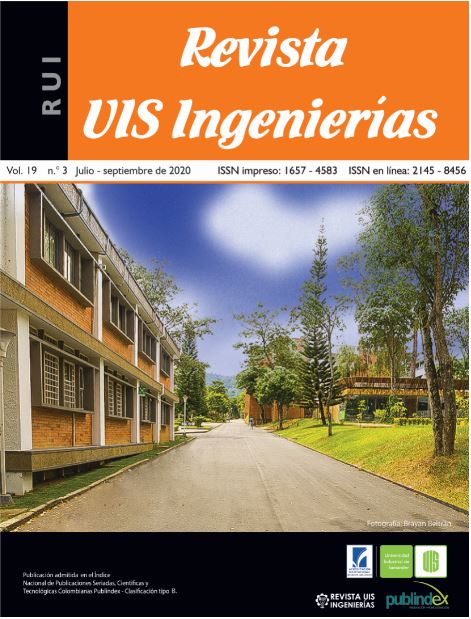Technological change in the naval industry using the friction spot- stir Welding (FSSW) Process
Published 2020-05-26
Keywords
- welding,
- friction,
- spot welding,
- naval industry
How to Cite
Copyright (c) 2020 Revista UIS Ingenierías

This work is licensed under a Creative Commons Attribution-NoDerivatives 4.0 International License.
Abstract
This article aims to respond to a technological demand from the TECNAO SRL shipyard, located in the San Fernando area in the province of Buenos Aires, Argentina, dedicated to the manufacture of small ships, made mainly of aluminum. The detected problem consists in the difficulty that arises in the manufacturing process of the ships, in relation to the positioning of the aluminum plates to be welded, which are positioned by means of a prior tapping. Currently, this activity is carried out using traditional MIG or TIG welding processes, which requires moving the torches throughout the entire barcode and the need for highly qualified personnel to carry out this task, which impacts strongly the cost and competitiveness of the sector, in addition to the problems of plate distortion due to the high temperatures associated with the processes used. The present work describes the studies carried out aimed at the design of a portable equipment for spot welding by friction-agitation (FSSW) for application in the naval industry. The FSSW solution was evaluated with an autonomous tool. The tool specified the structure stitching without the need for torch movement throughout the entire barcode, presented an additional complexity, welding thicknesses greater than 3 mm, this was relevant in the investigation.
Downloads
References
[2] B. Raj Singh, A Handbook on Friction Stir Welding. Reino Unido, UK: LAP Lambert Academic Publishing. 2012.
[3] M. Fujimoto, S. Koga, N. Abe, Y. S. Sato, H. Kokawa, “Microstructural analysis of stir zone of Al alloy produced by friction stir spot welding,” Sci. Technol. Weld. Join., vol. 13, no. 7, pp. 663–670, 2008, doi: 10.1179/136217108X347601
[4] C. D. Cox, B. T. Gibson, A. M. Strauss, G. E. Cook, “Effect of Pin Length and Rotation Rate on the Tensile Strength of a Friction Stir Spot-Welded Al Alloy: A Contribution to Automated Production,” Mater. Manuf. Process., vol. 27, no. 4, pp. 472–478, 2012, doi: 10.1080/10426914.2011.585503
[5] G. Buffa, L. Fratini, M. Piacentini, “On the influence of tool path in friction stir spot welding of aluminum alloys,” J. Mater. Process. Technol., vol. 208, no. 1 – 3, pp. 309 – 317, 2008, doi: 10.1016/j.jmatprotec.2008.01.001
[6] N.T. Nguyen, D.Y. Kim, H. Y. Kim, “Assessment of the failure load for an AA6061-T6 friction stir spot welding joint,” Proc. Inst. Mech. Eng. Part B J. Eng. Manuf., vol. 225, no. 10, pp. 1746 – 1756, 2011, doi: 10.1177/0954405411405911
[7] Hybe, “Una industria que se mantiene a flote,” Saber Cómo, no. 95, [En línea]. Disponible en: https://www.inti.gob.ar/sabercomo/sc95/inti10.php.
[8] H. Aydin, O. Tuncel, Y. Umur, M. Tutar, A. Bayram, “Effect of welding parameters on microstructure and mechanical properties of aluminum alloy AA 6082 T6friction stir spot welding,” Indian Journal of Engineering &Materiales Sciences, vol. 24, p.p. 215-227, 2017.
[9] H Aydin, O Tuncel, Y Umur, M Tutar, A Bayram, “Tool Pin Geometry Effect on Fracture Characteristics of 6082-T6 Friction Stir Spot Welds in Lap Shear Test,” 2nd International Conference on Advanced Engineering Technologies, [En línea]. Disponible en: https://www.researchgate.net/publication/320024232_Tool_Pin_Geometry_Effect_on_Fracture_Characteristics_of_6082T6_Friction_Stir_Spot_Welds_in_Lap_Shear_Test 2017.
[10] Z. Gao, J. T. Niu, F. Krumphals, N. Enzinger, S. Mitsche, C. Sommitsch, “FE modelling of microstructure evolution during friction stir spot welding in AA6082-T6,” Welding in the World, vol. 57, pp 895–902, 2013, 10.1007/s40194-013-0083-x
